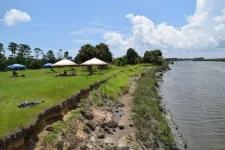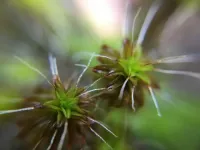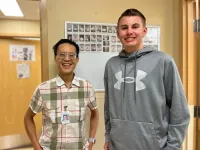(Press-News.org) Seattle is routinely listed as one of the most walkable and bike-friendly cities in the nation. The city government has committed to Vision Zero, which aims to completely eliminate traffic deaths and serious injuries by 2030, and embarked on a slew of infrastructure projects: expanding the city’s bike network, redesigning high-crash intersections and enhancing crosswalks to protect pedestrians.
Such safety projects sometimes meet opposition from local business owners, who worry that reduced parking and disruption to regular traffic flow will hurt their bottom line.
New research from the University of Washington suggests those worries are unfounded. Published this month in Injury Prevention, an analysis of seven safety projects across Seattle found they had no negative impact on the annual revenues of nearby businesses for three years after construction began. The results could help city officials gather support from local business owners and remove a barrier to fulfilling Seattle’s Vision Zero pledge.
“Some business owners may be concerned that Vision Zero pedestrian safety projects lead to a trade-off between safety and economic viability. Our research found there is no economic harm in improving safety, and such projects offer the health benefits of reducing injuries,” said study co-author Andrew Dannenberg, a UW affiliate professor of environmental and occupational health sciences and of urban planning.
The study was led by UW alumnus Daniel Osterhage, who completed the research for concurrent master’s degrees in public health and urban planning and now works at the Bill & Melinda Gates Foundation.
Researchers identified seven road safety projects of varying types, from the addition of bike lanes and crosswalks to speed limit adjustments and the removal of traffic lanes. The project sites were in six of Seattle’s seven council districts — they could not find a suitable project in West Seattle — and were all initiated between 2006 and 2014. All seven sites were commercially zoned and close to similar commercial zones that remained unchanged.
Using revenue data that each Washington business submits to the state, researchers established a baseline of taxable sales for businesses adjacent to each safety project, as well as for businesses in the nearby comparison areas. Researchers included only businesses that the state Department of Revenue database identified as “retail trade,” “accommodation and food services,” and “other services.” They excluded businesses from sectors that are less reliant on street-level activity, like manufacturing or construction.
In the three years after each safety intervention, researchers found no significant difference in the year-over-year change in revenue of the businesses in the intervention and comparison sites. On average, taxable sales increased in both the intervention and comparison sites over time, and at largely the same rate.
“If there had been a major impact of taking away parking spaces or disrupting traffic leading to a loss of business, you would expect sales to go down in places that had the interventions and not go down in the comparison sites,” Dannenberg said. “In fact, they stayed about the same, within statistical range. The sales data do not suggest any economic harm occurred, in fact there were a few instances where the safety interventions might have even helped sales.”
The study has some limitations. For example, researchers did not examine whether certain types of businesses might have been affected differently than others, or how factors like the supply of nearby parking spots unaffected by construction might have impacted the results.
Dannenberg, who serves on the Seattle planning commission, believes this work may help facilitate communication between city planners and business interests.
“A walkable environment generally encourages business,” Dannenberg said. “I think this work has implications that will be useful to policy makers who work on pedestrian safety and livable community issues.”
Other co-authors are Jessica Acolin and Paul Fishman of the Department of Health Systems and Population Health in the UW School of Public Health.
For more information, contact Dannenberg at adannen@uw.edu.
END
Vision Zero road safety projects in Seattle are unlikely to have negative impacts on local business sales, UW study finds
2024-02-28
ELSE PRESS RELEASES FROM THIS DATE:
African great apes predicted to see frequent extreme climate events in the next 30 years
2024-02-28
African apes are already being exposed to climate change impacts, and will experience extreme events such as wildfires, heatwaves and flooding more frequently in the next 30 years, according to a study publishing February 28 in the open-access journal PLOS Climate by Razak Kiribou at Haramaya University in Ethiopia and colleagues.
To better understand how African great apes will be affected by climate change, researchers investigated past and future climate for 363 sites across Africa. They estimated temperature and rainfall at each site between 1981 and 2010. Using two climate change scenarios, they projected how frequently apes would be exposed to climate change impacts in the near ...
EU countries have seen a decade of progress towards their 2030 sustainable energy goal
2024-02-28
Countries in the European Union (EU) have made progress over the past decade toward Sustainable Development Goal 7 (SDG 7), which calls for “access to affordable, reliable, sustainable and modern energy for all” by 2030, according to a study published February 28, 2024 in the open-access journal PLOS ONE by Marek Walesiak from Wroclaw University of Economics and Business, Poland, and Grażyna Dehnel from Poznań University of Economics and Business, Poland.
In 2015, the United Nations developed 17 global Sustainable Development Goals to be achieved by 2030. Tenets of SDG 7 include universal access to affordable energy; increased renewable energy ...
Climate change threatens thousands of archaeological sites in coastal Georgia
2024-02-28
Thousands of historic and archaeological sites in Georgia are at risk from tropical storm surges, and that number will increase with climate change, according to a study published February 28, 2024 in the open-access journal PLOS ONE by Matthew D. Howland and Victor D. Thompson of Wichita State University and the University of Georgia.
Anthropogenic climate change poses a major risk to coastlines due to rising sea level and increasingly severe tropical storms. This threatens not only living populations but also historic and archaeological sites. Mitigating damage requires accurate assessments of risks, but most predictive models focus on projected ...
Pet dogs with diarrhea may be shedding multi-drug resistant E.coli in 5 in 10 cases, with potential risks to their human owners
2024-02-28
Pet dogs with diarrhea may be shedding multi-drug resistant E.coli in 5 in 10 cases, with potential risks to their human owners
###
Article URL: https://journals.plos.org/plosone/article?id=10.1371/journal.pone.0298053
Article Title: Characteristics of MDR E. coli strains isolated from Pet Dogs with clinic diarrhea: A pool of antibiotic resistance genes and virulence-associated genes
Author Countries: China
Funding: This research was funded by the National Key Research and Development Program of China (2018YFD0500900, ...
Harassment on public transport negatively impacts women's health and welfare, with existing measures being largely ineffective, per systematic review
2024-02-28
Harassment on public transport negatively impacts women's health and welfare, with existing measures being largely ineffective, per systematic review
###
Article URL: https://journals.plos.org/plosone/article?id=10.1371/journal.pone.0296830
Article Title: Invasion of privacy or structural violence? Harassment against women in public transport environments: A systematic review
Author Countries: Spain
Funding: This study has been supported by the research grant ACIF/2020/035 from the "Generalitat Valenciana". The funding entity did not contribute to the study design or data collection, analysis, interpretation, or writing the manuscript. There was no additional ...
How the SARS-CoV-2 virus acquires its spherical shape
2024-02-28
RIVERSIDE, Calif. -- For centuries, coronaviruses have triggered health crises and economic challenges, with SARS-CoV-2, the coronavirus that spreads COVID-19, being a recent example. One small protein in SARS-CoV-2, the Membrane protein, or M protein, is the most abundant and plays a crucial role in how the virus acquires its spherical structure. Nonetheless, this protein’s properties are not well understood.
A research team led by a physicist at the University of California, Riverside, has devised a new method to make large quantities of M protein, and has characterized the protein’s ...
A step toward personalized immunotherapy for all
2024-02-28
LA JOLLA, CA—Most cancers are thought to evade the immune system. These cancers don't carry very many mutations, and they aren’t infiltrated by cancer-fighting immune cells. Scientists call these cancers immunologically "cold."
Now new research suggests such cancers aren't as "cold" as once thought. Researchers from the La Jolla Institute for Immunology (LJI), UC San Diego Moores Cancer Center, and UC San Diego, have found that patients with "cold" tumors actually do make cancer-fighting T cells.
This discovery opens the door to developing vaccines or therapies to increase T cell ...
Drying without dying: Tracing water scarcity coping mechanisms from mosses to flowering plants
2024-02-28
Imagine: You find the dried-up remains of a once green and lush philodendron on your bookshelf and realize you can’t remember the last time you watered your houseplants. You soak the soil with water, hoping you can breathe life back into its desiccated husk, but it is futile. The plant has been too dehydrated for too long, and irreparable damage has been done.
Now imagine that it isn’t your neglected houseplants that have been subjected to an unexpectedly dry growing season, but a field of wheat. With changes in global climate, such things are becoming more common and more of a concern for farmers, consumers, and researchers alike as the threat to food security intensifies.
But ...
Study finds drought fuels invasive species after wildfires
2024-02-28
Irvine, Calif., Feb. 28, 2024 — In a study recently published in the journal Ecology, University of California, Irvine scientists uncover the intricate dance between drought, wildfires and invasive species in Southern California's coastal sage scrub ecosystems.
Titled “Long-term drought promotes invasive species by reducing wildfire severity,” the research, led by Sarah Kimball, Ph.D., director of the Center for Environmental Biology at UCI, sheds light on the critical interplay of these factors and its ...
A safer treatment path for high-risk children to overcome food allergies
2024-02-28
New research from the University of British Columbia reveals a safe path to overcoming food allergies for older children and others who can’t risk consuming allergens orally to build up their resistance.
It’s called sublingual immunotherapy (SLIT), and it involves placing smaller amounts of food allergens under the tongue.
A study conducted by UBC clinical professor and pediatric allergist Dr. Edmond Chan and his team at BC Children’s Hospital Research Institute found SLIT to be as safe and effective for high-risk older children and adolescents ...








